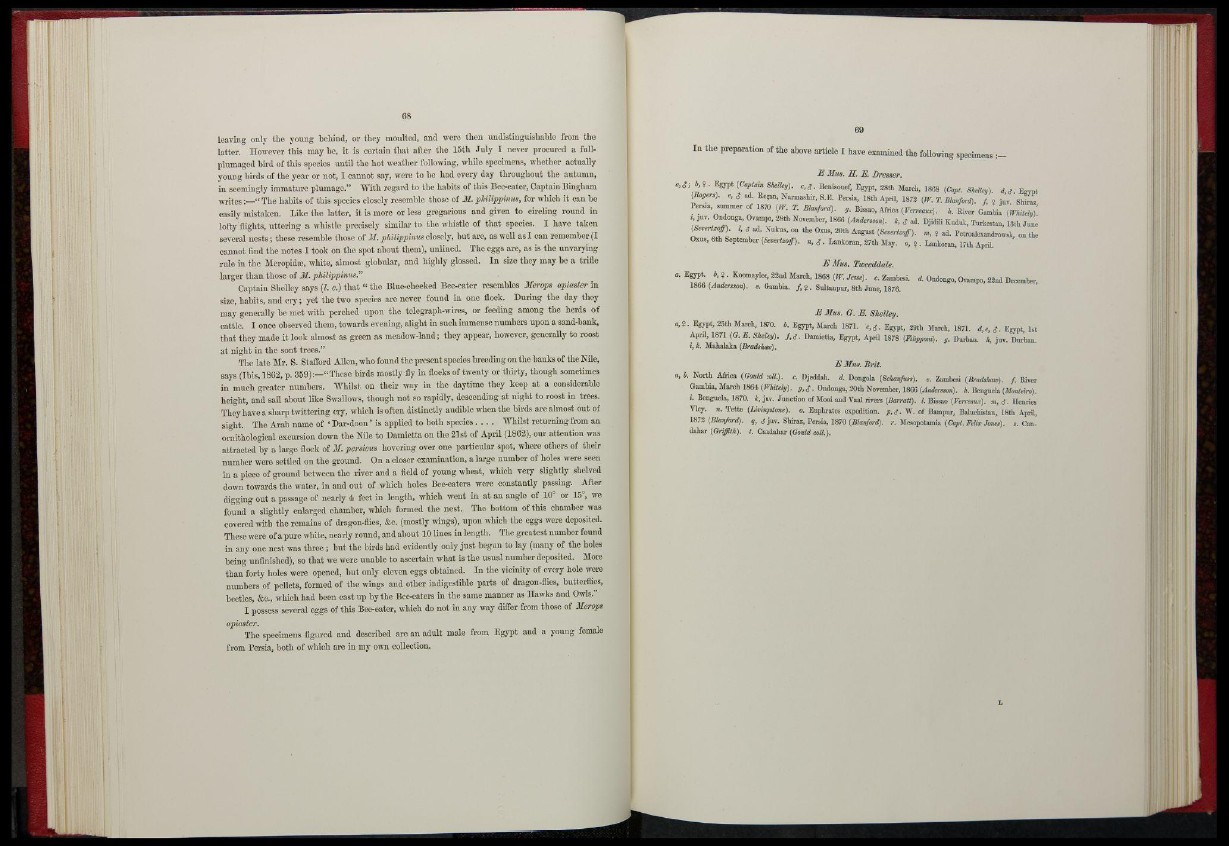
OS
leaving only the young behind, or they moulted, and were then undistinguishable from the
latter. However this may he, it is certain that after the 15th July I never procured a fullplumaged
bird of this species until the hot weather following, while specimens, whether actually
young birds of the year or not, I cannot say, were to be had every day throughout the autumn,
in seemingly immature plumage." With regard to the habits of this Bee-eater, Captain Bingham
writes :—" The habits of this species closely resemble those of M. philippimts, for which it can be
easily mistaken. Like the latter, it is more or less gregarious and given to circling round in
lofty flights, uttering a whistle precisely similar to the whistle of that species. I have taken
several nests; these resemble those of M. philippimis closely, but are, as well as I can remember (I
cannot find the notes I took on the spot about them), unlined. The eggs are, as is the unvarying
rule in the Meropida>, white, almost globular, and highly glossed. In size they may bo a trifle
larger than those of M.philippimts."
Captain Shelley says (/. c.) that " the Blue-cheeked Bee-eater resembles Merops apiasler in
size, habits, and cry; yet the two species are never found in one flock. During the day they
may generally be met with perched upon the telegraph-wires, or feeding among the herds of
cattle. I once observed them, towards evening, alight in such immense numbers upon a sand-bank,
that they made it look almost as green as meadow-land; they appear, however, generally to roost
at night in the sont trees."
The late Mr. S. Stafford Allen, who found the present species breeding on the banks of the Nile,
says (Ibis, 1862, p. 359):—"These birds mostly fly in flocks of twenty or thirty, though sometimes
in much greater numbers. Whilst on their way in the daytime they keep at a considerable
height, and sail about like Swallows, though not so rapidly, descending at night to roost in trees.
They have a sharp twittering cry, which is often distinctly audible when the birds are almost out of
sight. The Arab name of 'Dar-doon' is applied to both species . . . . Whilst returning from an
ornithological excursion down the Nile to Damietta on the 21st of April (1802), our attention was
attracted by a large flock of M. persicus hovering over one particular spot, where others of their
number were settled on the ground. On a closer examination, a large number of holes were seen
in a piece of ground between the river and a field of young wheat, which very slightly shelved
down towards the water, in and out of which boles Bee-caters were constantly passing. After
digging out a passage of nearly 4, feet in length, which went in a t an angle of 10° or 15°, we
found a slightly enlarged chamber, which formed the nest. The bottom of this chamber was
covered with the remains of dragon-flies, &c. (mostly wings), upon which the eggs were deposited.
These were of a pure white, nearly round, and about 10 lines in length. The greatest number found
in any one nest was three ; but the birds had evidently only just begun to lay (many of the holes
being unfinished), so that we were unable to ascertain what is the usual number deposited. More
than forty boles were opened, but only eleven eggs obtained. In the vicinity of every hole were
numbers of pellets, formed of the wings and other indigestible parts of dragon-flies, butterflies,
beetles, &C, which had been cast up by the Bee-caters in the same manner as Hawks and Owls."
I possess several eggs of this Bee-eater, which do not in any way differ from those of Merops
apiasler.
The specimens figured and described arc an adult male from Egypt and a young female
from Persia, both of which are in my own collection.
In the preparation of the above article I have examined the following specimens :—
E Mm. H. E. Dresser.
o*i M - Egvpt (Captain Shelley). c,<J. BeniBouef, Egypt, 28th March, 1868 (Capt. Shelley). d,i. Egypt
(Rogers), e, <J ad. Regan, Narmashir, S.E. Persia, 18th April, 1872 (IV. T. Blanford). ƒ, J JUT. Shiraz,
Persia, summer of 1870 (IV. T. Blanford). g. Bissao, Africa (Verreaux). A. River Gambia (Whitely).
i, juv. Ondonga, Ovampo, 28th November, 1866 (Andersson). k, J ad. DjidiU Kuduk, Turkestan, 13th June
(Severtzoff). I, rf ad. Nukus, on the Oxus, 20th August (SeverUoff). m, ? ad. Petroalexandrowsk, on the
Oxus, 6th September (Severtzoff). n, <J . Lankorau, 27th May. o, % . Lankoran, 17th April.
E Mm. Tweeddale.
• EgyP1- °> ? • Koomaylce, ¡¡2nd March, 1868 (IV. Jesse), c. Zambesi, d. Ondougo, Ovampo, 22nd December,
1866 (Andersson). e. Gambia, ƒ, % . Sultanpur, 8th June, 1876.
E Mus. O. E. Shelley.
Egypt, 25th March, 1870. b. Egypt, March 1871. c.cJ. Egypt, 29th March, 1871. d,e, £. Egypt, 1st
April, 1871 (G. E. Shelley). /,<J- Damietta, Egypt, April 1878 (Filipponi). y. Durban, ft, juv. Durban.
i,k, Mahalaka (Bradshaw).
E Mm. Brit.
,b. North Africa (Gould coll.). c. Djeddah. d. Dongola (Schaufuss). e. Zambesi (Bradshaw). f. River
Gambia, March 1861 (Whitely). g,£. Ondonga, 20th November, 1866 (Andersson). ft. Benguela (Monteiro).
i. Bcugucla, 1870. k, juv. Junction of Mooi and Vaal rivers (Barrett). I. Bissao (Verreaux). m, 6. Henries
Vley. n. Tette (Livingstone), o. Euphrates expedition. p,S- W. of Bampur, Baluchistan, 18th April,
1872 (Blanford). q, d juv. Shiraz, Persia, 1870 {Blanford). r. Mesopotamia (Capt. Felix Jones), s. Candahar
(Griffith), t. Candabar (Gould coll.).